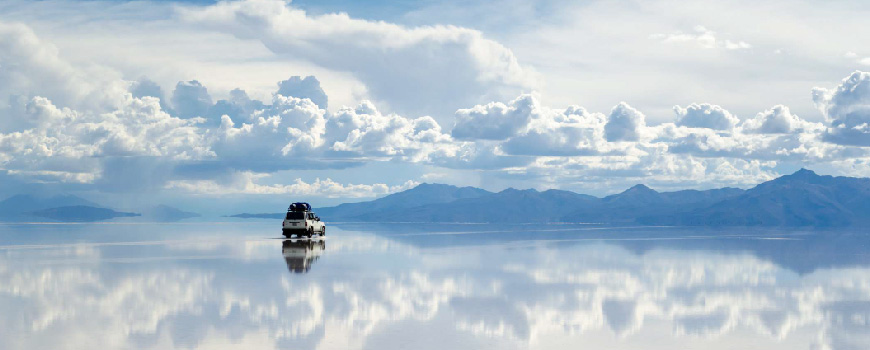

If you are a traveler in search of a destination that seamlessly blends charm, adventure, and cultural richness, look no further than Bolivia. This South American gem is a country of stark contrasts, from the heart-pounding adventures it offers to the breathtaking natural scenery and the uniquely vibrant local culture. With so much to see and do in this beautiful country, people often feel overwhelmed which is why we’ve compiled everything you need to know in this Bolivia Travel Guide.

Nestled in the Andes Mountains, La Paz is a city that quite literally touches the clouds. As the highest capital city in the world, it’s Perched between 3300 and 4100 meters above sea level, La Paz is the world’s highest capital city offers an array of activities to captivate any traveler. From heart-pounding experiences like the Mi Teleferico (cable cars) to culturally immersive explorations, La Paz leaves visitors spellbound. Its unique combination of altitude, landscape, and attractions make it one of the best tourist attractions in Bolivia.
Uyuni Salt Flats: Nature’s Mirror
No visit to Bolivia would be complete without a trip to the famous Salar de Uyuni, the world’s largest salt flat spanning a staggering 4,086 square miles. A former prehistoric lake turned into a vast desert-like expanse of white salt and rock formations, the Salar de Uyuni offers a surreal landscape that’s truly one of a kind. The salt flats reflect the sky so perfectly during the rainy season that they become a natural mirror, creating an otherworldly experience that must be seen to be believed.
Laguna Verde: A Gem of Emerald Beauty
Imagine a stunning emerald-green lake set against the backdrop of the majestic Licancabur volcano – that’s Laguna Verde. The name literally translates to ‘green lake,’ and its vibrant hue is indeed captivating. With three species of flamingos, Laguna Verde’s green waters beautifully contrast with the pink of the flamingos and the reddish-brown tones of the nearby hot springs. The sheer beauty and unique combination of colors make Laguna Verde an absolute highlight of any Bolivia travel itinerary.
Stone Tree: A Sculpture of Nature
In the heart of the Siloli Desert’s altiplano sand dunes stands the Stone Tree, a remarkable rock formation crafted by the elements over millennia. Standing in the heart of the Siloli Desert’s altiplano sand dunes, the Stone Tree is a remarkable rock formation sculpted by the elements over millennia, resembling a stunted tree. Located in one of the driest places on Earth, the Stone Tree is a symbol of the rugged beauty that defines Bolivia’s landscapes.
Valle de la Luna: A Lunar Illusion
Venture into the Atacama Desert, the driest desert on the planet, and you’ll discover the legendary Valle de la Luna (Valley of the Moon). Surrounded by towering volcanic peaks, this valley presents a captivating optical illusion during sunrise and sunset. The varying mineral content of the mountains creates an ever-changing display of colors, offering an experience akin to stepping onto another world,especially during sunrise and sunset

Explore Amazon Rainforest: Immerse yourself in the incredible biodiversity of the Amazon rainforest, home to rare species and vibrant flora. Take guided tours to witness exotic wildlife, vibrant birds, and the lush greenery that defines this tropical paradise.
Hike the Inca Trail: Embark on a journey through history by trekking the Inca Trail. Discover ancient ruins, such as Tiwanaku, and experience the sacred sites that tell the story of Bolivia’s rich past. The journey is not just a physical challenge but also a cultural and historical immersion.
Discover the Salt Flats by Jeep: Take a guided jeep tour across the mesmerizing Uyuni Salt Flats. Capture mind-bending perspective photos on the endless white expanse, visit the Isla Incahuasi with its giant cacti, and stay in unique salt hotels for an otherworldly experience.
Visit Potosi’s Mines: Delve into the history of Potosi, once a center of silver mining. Take a guided tour of the Cerro Rico mines to understand the challenges faced by the miners and learn about the historical significance of this industry.
Bolivian Cooking Classes: Immerse yourself in the local culture by taking a Bolivian cooking class. Learn to prepare traditional dishes like salteñas (pastries filled with meat and vegetables) and chuño (freeze-dried potatoes) while gaining insights into the country’s culinary traditions.
Ride the Death Road: For adrenaline seekers, the Yungas Road, also known as the “Death Road,” offers a thrilling mountain biking experience. Descend from the heights of the Andes into the lush Yungas region, taking in breathtaking views and heart-pounding excitement.
Experience Spiritual Healing: Bolivia is home to various spiritual and mystical practices. Experience traditional ceremonies and rituals with local healers and shamans for insights into Bolivian spirituality and belief systems.
Marvel at Colonial Architecture: Wander through the charming streets of Sucre and explore its colonial architecture. Visit historic buildings, churches, and museums that showcase the country’s rich history and culture.

Altitude Precautions: Give your body enough time to acclimate to high altitudes before engaging in strenuous activities to avoid altitude sickness.
Transportation Choices: Bolivia’s transportation options can vary widely in terms of comfort and safety. Choose reputable tour operators for activities like trekking, and opt for licensed taxis or ride-sharing services in cities for a safer transportation experience.
ATMs: The local currency is Bolivianos. ATM availability may be limited in some areas, so plan accordingly. It’s advisable to carry a mix of cash and cards. Before using an ATM, opt for ones located within reputable banks or secure locations.
Local Etiquette: Bolivian culture places a strong emphasis on personal relationships. Spanish is the official language. Take time to greet people properly, using appropriate titles like “señor” and “señora. Bolivianos is the local currency, and Spanish is the official language. Learning some basic Spanish phrases can be helpful.
Cultural Sensitivity: Bolivia’s indigenous cultures are an integral part of the country’s identity. Show respect by learning about their traditions and asking for permission before participating in or observing cultural practices. Always ask for permission before taking photos of individuals, especially in indigenous communities.
Choosing the right time to visit Bolivia can greatly enhance your travel experience. Bolivia’s diverse geography means that different regions have varying climates, so the best time to visit depends on your interests and the activities you have in mind.

This period is generally considered the best time for visiting Bolivia, especially if you’re planning outdoor activities and sightseeing. The weather is relatively dry, and the skies are often clear. During these months, you can comfortably explore cities, enjoy outdoor adventures, and trek in the Andes. It’s also the peak tourist season, so popular destinations might be busier.
La Paz and the Andes: The dry season is perfect for exploring cities like La Paz and engaging in outdoor activities such as hiking, mountain biking, and exploring the Uyuni Salt Flats. The weather is cool, and the skies are clearer, offering great visibility for stunning vistas.
Amazon Rainforest: The dry season is also suitable for exploring the Amazon rainforest. While it might still rain occasionally, it’s less likely to experience heavy downpours. This is a good time for wildlife spotting and bird-watching.

This season brings more rainfall and can vary from light showers to heavy rain, particularly in the Amazon basin and lowland areas. While some areas might be more challenging to access due to muddy roads, the wet season offers its own unique charm and advantages.
Salt Flats and Uyuni: The rainy season (December to March) transforms the Salar de Uyuni into a giant mirror, reflecting the sky and creating stunning photography opportunities. It’s a breathtaking spectacle that draws photographers and nature enthusiasts alike.
Less Crowded: The wet season is generally less crowded, making it a good time to visit if you prefer a quieter and more intimate travel experience. Just be prepared for the possibility of disrupted transportation in some areas due to heavy rain.
Bolivia, the heart of South America, is a land of boundless diversity – mountains, deserts, and jungles come together to create a tapestry of landscapes unlike any other.
Whether you seek heart-pounding adventures, serene natural beauty, or a unique cultural experience, Bolivia offers it all.
In conclusion, Bolivia is a land of contrast and intrigue. So, if you’re seeking a travel experience that’s as diverse as it is captivating, make sure to include Bolivia in your travel plans. This Bolivia Travel Guide has only scratched the surface – the heart of South America is ready to reveal its wonders to you.
At Adventures Overland, we love sharing our adventures with people who share the same passion for roads as we do. Be it by sharing our travel guides, providing insightful tips, or simply answering questions you, as a reader, might have. So, don’t shy away from hitting us up in the comments below.
Curating and enabling incredible on-the-road experiences that are unlike anything else you can find.
Safety is paramount. We ensure that you are safe and secure across all terrains.
If it’s not extraordinary, we either won’t do it or we’ll find a way to make it so.
It’s impossible not to love and care for the land with these amazing adventures.
© 2023 ADVENTURES OVERLAND. ALL RIGHTS RESERVED | PRIVACY POLICY
